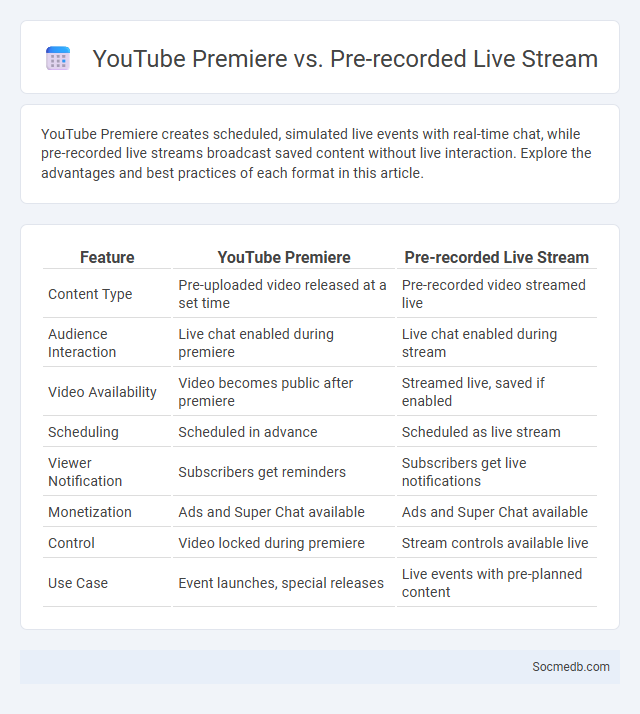
Photo illustration: YouTube Premiere vs Pre-recorded Live Stream
YouTube Premiere creates scheduled, simulated live events with real-time chat, while pre-recorded live streams broadcast saved content without live interaction. Explore the advantages and best practices of each format in this article.
Table of Comparison
| Feature | YouTube Premiere | Pre-recorded Live Stream |
|---|---|---|
| Content Type | Pre-uploaded video released at a set time | Pre-recorded video streamed live |
| Audience Interaction | Live chat enabled during premiere | Live chat enabled during stream |
| Video Availability | Video becomes public after premiere | Streamed live, saved if enabled |
| Scheduling | Scheduled in advance | Scheduled as live stream |
| Viewer Notification | Subscribers get reminders | Subscribers get live notifications |
| Monetization | Ads and Super Chat available | Ads and Super Chat available |
| Control | Video locked during premiere | Stream controls available live |
| Use Case | Event launches, special releases | Live events with pre-planned content |
Introduction: Understanding YouTube’s Live and Premiere Options
YouTube's Live and Premiere features enable real-time and scheduled video engagement, enhancing audience interaction through chat and notifications. Live streaming supports immediate viewer feedback, while Premieres create anticipation by releasing pre-recorded content as a live event. These tools optimize content delivery and increase visibility, driving higher viewer retention and community growth on the platform.
What is YouTube Premiere?
YouTube Premiere is a feature that allows creators to debut pre-recorded videos as a live moment, generating real-time audience interaction through live chat and countdown timers. Your viewers can watch the new content together at the scheduled premiere time, enhancing engagement and building anticipation. This tool boosts visibility by notifying subscribers and leveraging social features to maximize reach and community involvement.
What is a Pre-recorded Live Stream?
A pre-recorded live stream is a video broadcast recorded in advance and then streamed as if it were happening in real-time on social media platforms like Facebook, YouTube, or Instagram. This technique allows you to edit content for quality, control timing, and engage with your audience in a live chat during the playback. Using pre-recorded live streams enhances content delivery while maintaining the interactive experience of traditional live broadcasts.
Key Differences: Premiere vs Pre-recorded Live Stream
Premiere streams allow creators to schedule and debut pre-recorded videos in real-time, enabling live chat interaction during the broadcast, whereas pre-recorded live streams utilize streaming software to simulcast recorded content as if it were live, often lacking real-time engagement features. Premieres generate anticipation with a countdown and enable community participation, while pre-recorded live streams offer greater control over content quality without interactive chat timing constraints. Understanding these differences helps optimize audience engagement strategies and content delivery on social media platforms like YouTube and Facebook.
Audience Engagement: Live Chat and Real-time Interaction
Live chat and real-time interaction on social media platforms significantly boost audience engagement by facilitating instant communication between brands and users. These features increase user participation, improve customer satisfaction, and foster a sense of community by enabling immediate responses and dynamic conversations. Platforms such as Instagram Live, Facebook Messenger, and Twitter Spaces exemplify how real-time interaction drives higher engagement rates and strengthens brand loyalty.
Scheduling and Promotion Features
Social media platforms offer advanced scheduling features that enable users to plan and automate content posting across multiple channels, optimizing audience engagement times. Promotion tools leverage targeted advertising algorithms and analytics to enhance reach and boost visibility, driving higher conversion rates. Integrating scheduling with promotional campaigns streamlines content management and maximizes marketing ROI.
Monetization Opportunities
Social media platforms offer diverse monetization opportunities including sponsored content, affiliate marketing, and subscription-based models. Influencers leverage brand partnerships and product placements to generate significant revenue streams. Emerging features like live shopping and in-app tipping further enhance income potential for creators.
Use Cases: When to Use Each Format
Short-form videos excel in capturing attention quickly on platforms like TikTok and Instagram Reels, making them ideal for brand awareness and viral campaigns. Carousel posts on Facebook and LinkedIn effectively showcase multiple products or detailed content, enhancing user engagement and information retention. Stories offer real-time updates and interactive features, perfect for behind-the-scenes glimpses and limited-time promotions that drive immediate action.
Pros and Cons Comparison Table
Social media platforms offer extensive benefits such as enhanced global connectivity, brand visibility, and real-time information sharing, driving significant user engagement across demographics. However, drawbacks include privacy concerns, misinformation spread, and potential mental health impacts like anxiety and depression linked to prolonged use. A pros and cons comparison table highlights advantages such as networking opportunities and marketing reach against disadvantages like data vulnerability and digital addiction risks.
Conclusion: Choosing the Best Option for Your Content
Selecting the best social media platform for your content depends on identifying where your target audience is most active and what type of content resonates with them, such as Instagram for visual storytelling or LinkedIn for professional insights. Analyzing engagement metrics like reach, click-through rates, and follower growth helps fine-tune your strategy and maximize your content's impact. Regularly reassessing platform updates and user trends ensures sustained relevance and effective audience connection.
 socmedb.com
socmedb.com